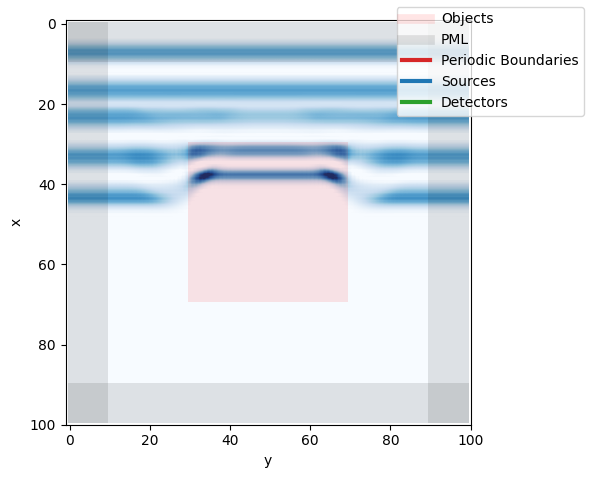04. Performance Profiling
We can profile the performance with a 3D FDTD simulation:
Imports
[1]:
import matplotlib.pyplot as plt
from line_profiler import LineProfiler
import fdtd
import fdtd.backend as bd
Set Backend
Let’s profile the impact of the backend. These are the possible backends:
numpy(defaults to float64 arrays)torch(defaults to float64 tensors)torch.float32torch.float64torch.cuda(defaults to float64 tensors)torch.cuda.float32torch.cuda.float64
[2]:
fdtd.set_backend("numpy")
In general, the numpy backend is preferred for standard CPU calculations with "float64" precision as it is slightly faster than torch backend on CPU. However, a significant performance improvement can be obtained by choosing torch.cuda on large enough grids.
Note that, in FDTD, float64 precision is generally preferred over float32 to ensure numerical stability and prevent numerical dispersion. If this is of no concern to you, you can opt for float32 precision, which especially on a GPU might yield a significant performance boost.
Constants
[3]:
WAVELENGTH = 1550e-9
SPEED_LIGHT: float = 299_792_458.0 # [m/s] speed of light
Setup Simulation
create FDTD Grid
[4]:
N = 100
grid = fdtd.Grid(
(N, N, N),
grid_spacing=0.05 * WAVELENGTH,
permittivity=1.0,
permeability=1.0,
)
add boundaries
[5]:
# x boundaries
grid[0:10, :, :] = fdtd.PML(name="pml_xlow")
grid[-10:, :, :] = fdtd.PML(name="pml_xhigh")
# y boundaries
grid[:, 0:10, :] = fdtd.PML(name="pml_ylow")
grid[:, -10:, :] = fdtd.PML(name="pml_yhigh")
# z boundaries
grid[:, :, 0:10] = fdtd.PML(name="pml_zlow")
grid[:, :, -10:] = fdtd.PML(name="pml_zhigh")
add sources
[6]:
grid[10+N//10:10+N//10, :, :] = fdtd.PlaneSource(
period=WAVELENGTH / SPEED_LIGHT, name="source"
)
add objects
[7]:
grid[10+N//5:4*N//5-10, 10+N//5:4*N//5-10, 10+N//5:4*N//5-10] = fdtd.Object(permittivity=2.5, name="center_object")
grid summary
[8]:
print(grid)
Grid(shape=(100,100,100), grid_spacing=7.75e-08, courant_number=0.57)
sources:
PlaneSource(period=35, amplitude=1.0, phase_shift=0.0, name='source', polarization='z')
@ x=[20, ... , 21], y=[0, ... , 100], z=[0, ... , 100]
boundaries:
PML(name='pml_xlow')
@ x=0:10, y=:, z=:
PML(name='pml_xhigh')
@ x=-10:, y=:, z=:
PML(name='pml_ylow')
@ x=:, y=0:10, z=:
PML(name='pml_yhigh')
@ x=:, y=-10:, z=:
PML(name='pml_zlow')
@ x=:, y=:, z=0:10
PML(name='pml_zhigh')
@ x=:, y=:, z=-10:
objects:
Object(name='center_object')
@ x=30:70, y=30:70, z=30:70
Setup LineProfiler
create and enable profiler
[9]:
profiler = LineProfiler()
profiler.add_function(grid.update_E)
profiler.enable()
Run Simulation
run simulation
[10]:
grid.run(50, progress_bar=True)
100%|██████████| 50/50 [00:13<00:00, 3.73it/s]
Profiler Results
print profiler summary
[11]:
profiler.print_stats()
Timer unit: 1e-09 s
Total time: 6.6444 s
File: /home/docs/checkouts/readthedocs.org/user_builds/fdtd/checkouts/latest/docs/examples/fdtd/grid.py
Function: update_E at line 275
Line # Hits Time Per Hit % Time Line Contents
==============================================================
275 def update_E(self):
276 """update the electric field by using the curl of the magnetic field"""
277
278 # update boundaries: step 1
279 300 451320.0 1504.4 0.0 for boundary in self.boundaries:
280 300 2487669484.0 8292231.6 37.4 boundary.update_phi_E()
281
282 50 2859277211.0 57185544.2 43.0 curl = curl_H(self.H)
283 50 746051675.0 14921033.5 11.2 self.E += self.courant_number * self.inverse_permittivity * curl
284
285 # update objects
286 50 194228.0 3884.6 0.0 for obj in self.objects:
287 50 72522680.0 1450453.6 1.1 obj.update_E(curl)
288
289 # update boundaries: step 2
290 300 340996.0 1136.7 0.0 for boundary in self.boundaries:
291 300 474581196.0 1581937.3 7.1 boundary.update_E()
292
293 # add sources to grid:
294 50 93652.0 1873.0 0.0 for src in self.sources:
295 50 3177339.0 63546.8 0.0 src.update_E()
296
297 # detect electric field
298 50 43737.0 874.7 0.0 for det in self.detectors:
299 det.detect_E()
Visualization
[12]:
plt.figure()
grid.visualize(z=N//2)
